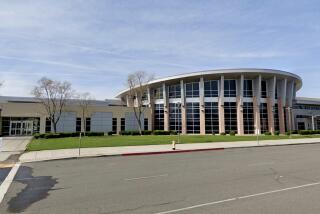Couldn’t Fly by ‘Book,’ Pilot of DC-10 Recalls
- Share via
SIOUX CITY, Iowa — When the tail engine exploded on United Airlines Flight 232, Capt. Alfred C. Haynes shut the engine down while second officer Dudley Dvorak got out the procedure book.
No one on the DC-10 knew exactly what had happened, but the flight crew hoped the book would tell them what they should do next.
“It was very shortly after that that we concluded we had more than an engine failure,” Haynes said Tuesday in his first talk with reporters since the crash last Wednesday. “It was apparent to us that we had lost all our hydraulic fluids.”
‘There Isn’t One’
“When I asked Dudley what was the procedure for that he said: ‘There isn’t one,’ ” Haynes recalled. “So we made one up as we went along.”
Using such calm, matter-of-fact language, the Paris, Tex., native explained publicly for the first time what happened during the 41-minute ordeal, during which he guided the crippled plane to a fiery landing in Sioux City. One hundred and eleven people died, but 185 survived the crash.
Investigators have said the flight crew brought the plane in largely by alternating thrusts from the two remaining engines. For some reason, the pilot was unable to make left turns after the engine exploded. Haynes would not answer questions in detail because the National Transportation Safety Board still has not finished its investigation.
The 57-year-old Haynes said he never feared for his life as the plane approached the runway.
Nor was he concerned that the plane might not make it to Sioux City after it became apparent that they could not reach Chicago, their scheduled destination.
“I honestly didn’t think about it,” he said. “We were going to try to go on there and land, and that’s what we tried to do.”
If the crew had believed that they weren’t going to make it, he said, “we couldn’t have operated.”
The pilot’s face and head still bore small bruises and scabs from the crash. He had a tiny bandage on the bridge of his nose.
Haynes said he lost consciousness in the crash. When he came to his senses, he was pinned in the cockpit, unable to move.
“I said to myself, don’t hyperventilate, and wait for somebody to come,” he recounted.
Asked what happened next, he said: “Somebody came.”
Haynes and second officer Dvorak, 51, both in wheelchairs, met with reporters upon their release from the Marian Health Center here, shortly before they and their families boarded a Lear jet for a non-stop flight to Seattle, where they both live.
The former Marine pilot is being hailed as a hero for his professionalism, which helped so many to survive.
He smiled when a reporter mentioned this.
“There is no hero,” he said. “There’s just a group of four people who did their jobs. It was an unusual circumstance, but we put our knowledge together and did what we thought best.”
The three-man flight crew was assisted during the ordeal by Dennis Fitch, 47, an off-duty United pilot who happened to be on the flight. He knelt on the cockpit floor between the other pilots and operated the engine throttles.
“Fitch was a member of our crew,” Haynes said. “We became a four-man crew instead of a three-man crew.”
The other member of the flight crew was first officer William R. Records, 49, who Haynes said was at the controls when the explosion occured. Records and Fitch both remain in the hospital.
“Everyone either helped in running the airplane or flying the airplane or doing the many, many radio reports that were required,” Haynes said. “Everybody kicked in . . .. Everybody agreed as a group to agree among ourselves before anything was done. And that was, I think, an important part of our survival.”
Haynes had kind words for the air traffic controllers who guided the flight crew in for the landing and for the ground rescue personnel and residents of Sioux City who offered help.
“Thank you for your compassion, for your caring and for your loving concern,” he said.
“This is a happy day for many of us,” Haynes said at the start of the press conference. “We must not forget that 111 people perished in the crash.
“This crew and in fact the entire industry are dedicated to finding out the cause of this accident so that it may never happen again.”
Haynes said that before last week he had never had major engine trouble during a flight. He had had what he termed “minor” problems with the engine and hydraulic systems, but they always were corrected before the plane left the airport, he said.
Asked if he had developed a fear of flying because of the crash, the pilot chuckled. “I’m flying home today,” he said. “And I can’t wait to get back to work.”
More to Read
Sign up for Essential California
The most important California stories and recommendations in your inbox every morning.
You may occasionally receive promotional content from the Los Angeles Times.













